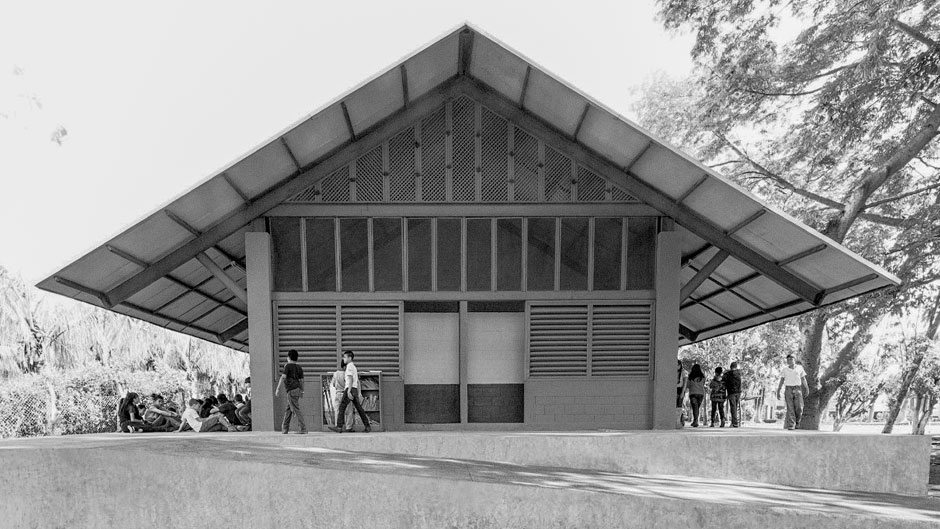If you visit Miami’s Design District, you may find yourself walking down a street surrounded by a colonnade that shields you from the strong tropical sun.
The shade is thanks to Carie Penabad and her partner Adib Cúre, both professors at the University of Miami School of Architecture. The street was part of a public space project called Oak Plaza.
Since 2001, the couple run CÚRE & PENABAD Architecture and Urban Design. In their work, they consciously immerse themselves in the culture and urbanism of the place to allow that to inform the architecture, said Penabad.
Climate, the surrounding environment, fauna, and cultural mores all play a role in their urban design and construction.
“One underlying theme of our work is a conscientious pursuit of an architecture of place. We immerse ourselves in the culture and in the urbanism of a place and then allow that to inform the architecture,” said Penabad, who is also associate dean of research and director of the undergraduate program at the School of Architecture.
For years, the duo has been engaged in mapping informal cities in Barranquilla, Colombia. The areas had developed organically but had no formal planning maps or blueprints to help with design or construction. Every spring semester from 2008 through 2015, they took students on trips to Barranquilla to map 75 neighborhood blocks, talking to people to find out their needs and observing social interactions. The project also used drones for the mapping in association with Chris Mader and his team of data scientists from the University of Miami Institute for Data Science and Computing (IDSC).
“The surveys we conducted went beyond architecture,” said Penabad. “We realized that they were helpful to a multitude of areas including showing which areas did not have running water or needed lights because of crime frequency. They even told us how many children lived in the block and whether they were vaccinated.”
In some cases, the mapping work allowed residents the means to negotiate with the government for the purchase of land, noted Penabad.
The couple was recently awarded the 2021 Emerging Voices award from the Architectural League of New York. They were one of eight recipients based in North America.
“Professors Carie Penabad and Adib Cúre are gathering momentum in their creative professional practice with several prestigious awards celebrating their excellent work,” said Rodolphe el-Khoury, dean of the School of Architecture. “This particular honor is one of the most coveted recognitions in the field; it testifies to the value of recent achievements as well as to the great potential of things to come. I look forward to more sustainable and resilient built work from the talented duo!”
“The jury carefully weighed all elements of the submissions, identifying eight individuals and firms engaged in a robust architecture, imbued with inventive approaches to social, racial, and economic equity, material invention, and ecological benefits,” stated Paul Lewis, a jury member and president of the Architectural League.
The duo’s entries for the contest included a school building they designed in Escuintla, Guatemala, to accommodate 200 students in five classrooms.
The project happened after years of visiting the area—a town along the southwestern coast of Guatemala, about 60 miles from Guatemala City—to design and construct a corporate headquarters for a local sugar mill.
“Every day we would pass by the school on our way to a nearby project site,” said Penabad. The roof was in disrepair and the classrooms were dark, humid, and without cross ventilation.”
Working alongside Yolanda Leal Toledo, a private donor and leader in educational initiatives throughout the country, and a local foundation, the couple decided to take on the project of designing and building one of the structures of Escuelita Buganvilia pro-bono. The result was a 3,200-square-foot, steel and concrete building, elevated from the ground and with an extended roof to protect the students from the rain. The windows provide cross ventilation and light and have screens to keep insects out. The materials used were similar to those used in surrounding structures, said Cúre.
According to Cúre, before starting the project, the couple spoke with students and teachers to determine their needs. In addition, they were careful not to disturb the many native trees surrounding the school. In designing the building, the partners followed the lessons they teach their students at the School of Architecture.
“We believe that architecture has to be connected to place and context,” he said. “It was one of the most fulfilling projects we have done because we believe it was a positive contribution to the community.”

